- Local time
- Today, 04:23
- Joined
- Jan 5, 2006
- Messages
- 54,119
- Points
- 1,327
- First Name
- Dave
- My Ride
- Speedmaster
- Riding Since
- 1974
Kawasaki is never at ease with its Z’s – especially the big one, which it keeps reinventing. Z1000 begat the new 2020 Z900, which is nearly as powerful, quite a bit lighter, nicer in every way and sells for many ducats less. The Speed Triple remains the Speed Triple, longer of tooth and less buggy of eyeball. In 2010, we cut them thin to see who would win, amen.
New-age contender takes on the icon
By Kevin Duke Feb. 26, 2010
Photography by Fonzie Video by Fonzie
In case you haven’t noticed, we’re big fans of naked sportbikes. Fast enough to thrill yet plenty accommodating for daily use, their do-it-all nature is highly appealing to us.Not only did the versatile and riotously fun Triumph Street Triple R take the Motorcycle of the Year award in our Best of 2009 article, we’ve also given plenty of ink to naked bikes in comparison tests. To wit:
Ducati Streetfighter vs Benelli TnT
Air-cooled V-Twin Streetfighter Shootout: Ducati Monster vs H-D XR1200
Aprilia Shiver vs Triumph Street Triple
Kawasaki ER-6n vs Suzuki Gladius
2009 Streetfighter Shootout: Aprilia Tuono, Buell 1125CR, Triumph Speed Triple
Which brings us to Kawasaki’s new Z1000 sports roadster. American riders have been reluctant to buy naked bikes such as this, but Kawasaki believes it has a winner on its hand with its ground-up redo of the streetfighting Z1K.
We became believers, too, after testing the Zee during its December press launch. It is a huge advancement over the previous generation Z1000, offering more grunt, sure-footed handling and less vibration. It proved to be so competent that we decided to see how it would fare against the endlessly appealing Triumph Speed Triple, a true icon of the genre that has been around since 1994.
Last seen on MO a little over a year ago in our 2009 Streetfighter Shootout, the Speed Triple remains unchanged since its 2008 update.
The Triumph’s centerpiece is its wonderful 1050cc three-cylinder engine. The endearing Triple is not only fabulously musical, it also proved to out-torque its twin-cylinder competition. Adding in its attractive bare-bones styling (with twin bug-eye headlights, snake-like aluminum frame and single-sided swingarm) only sweetens the deal. And, for a semi-exotic European sportbike, its $11,299 MSRP qualifies as a veritable deal.
Power Supply
No other component defines a motorcycle as much as its engine. Here for your pleasure are seven cylinders of near-seamless power that lofts front wheels and paints grins on faces.
It’s no secret we’re big fans of three-cylinder motors, and just Triumph and Benelli take advantage of their torquey-yet-revvy nature and tuneful exhaust notes. The tri-cylinder mill in the Speed Triple (and, in slightly detuned forms, Sprint ST and Tiger) has been around since 1997 and regularly updated, entering its 1050cc iteration in 2005. Updates to the ECU in 2008 cured the engine’s slow start-ups and erratic fueling.
The big, black lump in our test bike spat out its usual bottomless power, outputting more than 60 ft-lbs of torque by just 2200 rpm. It offers more than 65 ft-lbs from 3500 revs to its 9500-rpm ceiling, peaking with 69.1 ft-lbs at 7550 rpm. The fun stops at a 9500-rpm rev limit, not the 10.5K redline indicated on the tach.
The all-new Z1000 inline-Four measures up just 7cc short of the Triumph, and it’s remarkable how much grunt Kawasaki was able to build into its smaller cylinders. The Speed Triple has long been the torque king among liter-sized sports nakeds, yet the Z keeps pace surprisingly well – the previous 953cc Z1000 motor is far peakier than this new 1043cc powerplant. The fuel-injection’s throttle bodies measure a reasonably small 38mm, helping achieve higher intake velocities for snappier response.
The Z’s torque production converges with the Trumpet’s around 5000 revs, and that’s no mean feat for any engine, let alone a four-cylinder motor. There’s a give and take battle until 6700 rpm when the Kawi exerts its top-end dominance all the way to its 10,800-rpm rev limit.
Although some hardcore sportbikers might decry any tuning for torque, the Z1000’s mill is a gem in all street situations. The grunty engine is very civilized when ridden sedately, and Kawi has done an excellent job at damping annoying engine vibes from this latest Z.
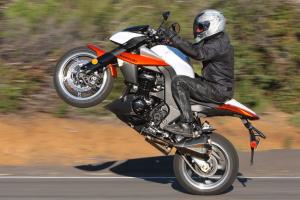 “Detuned” isn’t a word thought of when riding a Z1000.
“Detuned” isn’t a word thought of when riding a Z1000.
This isn’t to say the 1043cc powerplant is docile. Good clutch take-up feel and strong torque allow for Usain Bolt-like sprints from a stop, a rider able to float the front wheel from a near standstill. Published tests indicate the new Z is able to do 10.5-second quarter-miles and top out at nearly 150 mph.
Throttle response, like its styling, is sharp, except for occasional soggy response when grabbing big handfuls during roll-ons, as if the fuel-injection’s ECU-controlled sub-throttles aren’t sure how to react. Its gearbox was mostly light and smooth but occasionally notchy, sometimes not, and it seemed to improve with miles.
The Speed Triple’s three-pot motor remains eminently likeable, offering a smooth yet responsive feel with minimal vibration. The cable-actuated clutch provides predictable take-up, and the sweet-sounding powerplant is always ready to pull with authority. Gearbox action is a bit notchy but positive when switching cogs.
Swervery
Naked sportbikes like these are designed to offer supersport-like performance without the accompaniment of twisted ergonomics, and this pair delivers on that promise. Both are able to deftly transition from docile street scoot to ravenous corner eater.
The Z1000 easily tips into corners and nearly matches the agility of the flickable Mr. Speed. In the triumvirate of chassis geometry (rake, trail and wheelbase), the Triumph has the sportiest specs in two categories. Its 23.5-degree rake is 1.0 degree steeper than the Kawi, and its minimal 84mm of trail undercuts the Zee by 19mm. Its 56.1-inch wheelbase is longer by 0.4 inches, but its 180mm Metzeler Sportec M3 rear tire is easier to turn than the fatter 190 Dunlop D210 on its rival.
Pointed down a canyon road, the Speed Triple is very cooperative and easy to ride quickly. It’s not until ridden really aggressively that it becomes a bit unraveled, and its minimal amount of trail doesn’t offer the more secure feedback from the Kawi. On the other hand, the Z1000 retains its composure when pushed to its limits. It turns in quickly yet securely, responding without quirks, and it would transition to track work better than the looser Triumph.
“Within the first few curves encountered while aboard the new Z, one of the first impressions that came to mind was that this bike could easily go from the dealer floor straight to the racetrack,” says road-testing fool Pete Brissette. “From front to rear, the entire package feels taut, yet it’s not so rigid that it feels (or responds) like it’s uncomfortably stiff. “
Each bike has a really good set of binders, both utilizing a radial-pump master cylinder and radial-mount calipers on dual front discs. The Kawi’s Tokico calipers have a softer initial bite than the Trumpet’s Brembos but have plenty of power when squeezed deliberately, making them ideal for a streetbike. The Z’s 300mm front rotors are 20mm smaller than the Triple’s but don’t seem to suffer for it.
With their fuel tanks full, this duo weighs within a couple of pounds of each other, about 480 lbs. The S3 wins bonus marks for carrying 0.8-gallon more petrol than the Z1K’s smallish 4.0-gallon fuel tank.
Daily Grind
Both of these machines exemplify the livability of the naked sportbike genre. Their upright riding positions are much preferable to race-replica sportbikes during commuter and errand roles. The Speed Triple’s thickly padded seat, at 32.7 inches, is quite tall, while the Z1000’s stated seat height of 32.1 inches feels even lower than that. Shorties may prefer the Z saddle, but tall folks will appreciate the S3’s greater seat-to-peg distance. The Triumph’s seat has more padding, but the Z’s thinner seat is perfectly comfortable over hour-plus stints. The Speed Triple’s tapered aluminum Magura handlebar is placed a bit further from a rider than the Z’s bar.
This pair’s instrumentation provides similar info in different ways. The Triumph has a digital speedo set into an easily read analog tachometer, augmented by an LCD display on the left that includes a fuel gauge and clock. A gear-position indicator is absent from both bikes.
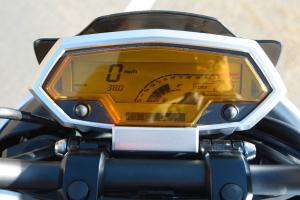 We’ve never been fond of bar-graph tachometers, and we like them less when they’re too small to see at a glance.
We’ve never been fond of bar-graph tachometers, and we like them less when they’re too small to see at a glance.
The Kawi’s gauges are more controversial. The single-pod unit can be cleverly tilted to three positions, but the yellow-tinted gauge face looks like something out of a J.C. Whitney catalog. Its display includes good stuff like a digital speedo, clock, twin tripmeters and fuel gauge, but we found the bar-graph LCD tachometer difficult to read at a glance. That said, the Zee has such a wide powerband that there’s seldom a reason to check engine speed. At night the LCD display turns red inside the yellow frame.
We like the Z1000’s turnsignals mounted unobtrusively in the vestigial side fairings and the smoothly contoured die-cast aluminum subframe that has integrated grab handles molded into its underside. Less thought was put into its mirrors that are placed too far inboard, necessitating an arm tuck when checking your Six. The Triumph’s mirrors make up in usability what they give up in style.
Despite what appears to be minimal wind protection, an 80-mph cruise on the Z1000 doesn’t batter the rider. Highways speeds are less comfortable on the totally naked Triumph, so we highly recommend the accessory flyscreen that helps divert the wind.
The suspensions of both bikes are fully adjustable, so riders of different sizes and abilities will be able to tune them in. The S3’s setup is a bit softer, which is appreciated when the roads are harsh but is less buttoned down when hammered. A new-for-2010 Special Edition Speed Triple ushers in an upgraded suspension for the model, using firmer damping and a slightly softer rear spring.
Style Council
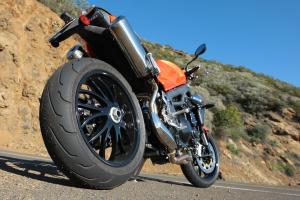 Despite its aging design, the Speed Triple remains a seductive hooligan machine.
Despite its aging design, the Speed Triple remains a seductive hooligan machine.
It’s tough to beat the stripped-down brawler personality of Triumph’s prototypical streetfighter, from its twin-headlight nose to its truncated rear. Bonus points are earned for the stubby high-mount mufflers and single-sided swingarm that expose the lovely rear wheel. An arbitrary point is deducted for the multitude of hoses cluttering up the engine, although they are camouflaged in a sea of black.
The future-forward styling of the Zee hits viewers in different ways. Some traditionalists see it as a caricature, but many expressed appreciation for its ultra-contemporary chunky design.
“Now that is a sick motorcycle!” raves MO forum member Kenneth Moore. “It looks mean as hell and ready to ride over a gaggle of nuns on their way to confession. The fairing gizmos that stick out from the sides are a little much, but it’s still dope. Neat, neat, neat.”
And The Winner Is…
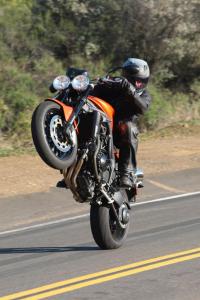 The Triumph Speed Triple: Still a thrill!
The Triumph Speed Triple: Still a thrill!
This was a close one. The three-cylinder Triumph has an undeniably desirable character. Its simple yet exotic styling has enduring appeal, and its torquey engine is a pleasure to feel and to hear.
“I used to think the Speed Triple was once a bike I’d always place in my Top 5 faves, but having now ridden the Z, the Speed has some tough competition,” Pete ponders. “Despite the Trumpet losing some performance ground to the new Z, the Kaw can’t hold a candle to the wonderfully raspy Triple exhaust note. And if you’ve ever heard a Triumph Triple fitted with aftermarket Arrow Exhaust systems, well, sir, that right there is the Speed’s siren song, wooing all who hear to come hither.”
The Speed Triple retails for a reasonable $11,299, definitely the best bang for the buck in Euro streetfighter realm. It’s cheaper by thousands than the Aprilia Tuono, Ducati Streetfighter and MV Agusta Brutale.
But so is Team K’s new urban-assault terror, and its ultimate performance limits are higher than the venerable Speed Triple’s. It is a sharper – styling, throttle response, suspension – tool. This is a machine that can holeshot a ZX-10R and run away from a well-ridden supersport on a twisty road.
Adding into the equation the Zee’s modest $10,499 MSRP (the same as a 600 supersport), and it becomes perhaps the best value in all of sportbikedom.
“The S3 is fun, but the Z1000 is more funner,” says Pete.” The re-born Zed is a sportbike slayer.”
Related Reading
2010 Kawasaki Z1000 Review
2009 Streetfighters Shootout
2008 Triumph Urban Sports Review
2008 Triumph Speed Triple Review
The post Church of MO: 2010 Streetfighter Shootout: Kawasaki Z1000 Vs. Triumph Speed Triple appeared first on Motorcycle.com.
Source...
New-age contender takes on the icon
By Kevin Duke Feb. 26, 2010
Photography by Fonzie Video by Fonzie
In case you haven’t noticed, we’re big fans of naked sportbikes. Fast enough to thrill yet plenty accommodating for daily use, their do-it-all nature is highly appealing to us.Not only did the versatile and riotously fun Triumph Street Triple R take the Motorcycle of the Year award in our Best of 2009 article, we’ve also given plenty of ink to naked bikes in comparison tests. To wit:
Ducati Streetfighter vs Benelli TnT
Air-cooled V-Twin Streetfighter Shootout: Ducati Monster vs H-D XR1200
Aprilia Shiver vs Triumph Street Triple
Kawasaki ER-6n vs Suzuki Gladius
2009 Streetfighter Shootout: Aprilia Tuono, Buell 1125CR, Triumph Speed Triple
Which brings us to Kawasaki’s new Z1000 sports roadster. American riders have been reluctant to buy naked bikes such as this, but Kawasaki believes it has a winner on its hand with its ground-up redo of the streetfighting Z1K.
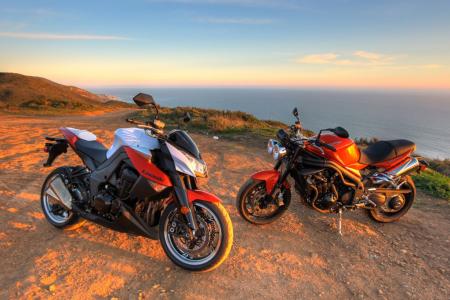
|
We became believers, too, after testing the Zee during its December press launch. It is a huge advancement over the previous generation Z1000, offering more grunt, sure-footed handling and less vibration. It proved to be so competent that we decided to see how it would fare against the endlessly appealing Triumph Speed Triple, a true icon of the genre that has been around since 1994.
Last seen on MO a little over a year ago in our 2009 Streetfighter Shootout, the Speed Triple remains unchanged since its 2008 update.
The Triumph’s centerpiece is its wonderful 1050cc three-cylinder engine. The endearing Triple is not only fabulously musical, it also proved to out-torque its twin-cylinder competition. Adding in its attractive bare-bones styling (with twin bug-eye headlights, snake-like aluminum frame and single-sided swingarm) only sweetens the deal. And, for a semi-exotic European sportbike, its $11,299 MSRP qualifies as a veritable deal.
Power Supply
No other component defines a motorcycle as much as its engine. Here for your pleasure are seven cylinders of near-seamless power that lofts front wheels and paints grins on faces.
It’s no secret we’re big fans of three-cylinder motors, and just Triumph and Benelli take advantage of their torquey-yet-revvy nature and tuneful exhaust notes. The tri-cylinder mill in the Speed Triple (and, in slightly detuned forms, Sprint ST and Tiger) has been around since 1997 and regularly updated, entering its 1050cc iteration in 2005. Updates to the ECU in 2008 cured the engine’s slow start-ups and erratic fueling.
The big, black lump in our test bike spat out its usual bottomless power, outputting more than 60 ft-lbs of torque by just 2200 rpm. It offers more than 65 ft-lbs from 3500 revs to its 9500-rpm ceiling, peaking with 69.1 ft-lbs at 7550 rpm. The fun stops at a 9500-rpm rev limit, not the 10.5K redline indicated on the tach.
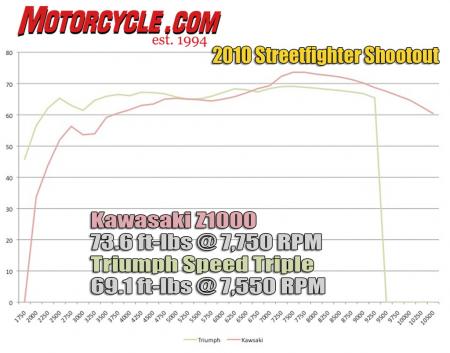
|
The all-new Z1000 inline-Four measures up just 7cc short of the Triumph, and it’s remarkable how much grunt Kawasaki was able to build into its smaller cylinders. The Speed Triple has long been the torque king among liter-sized sports nakeds, yet the Z keeps pace surprisingly well – the previous 953cc Z1000 motor is far peakier than this new 1043cc powerplant. The fuel-injection’s throttle bodies measure a reasonably small 38mm, helping achieve higher intake velocities for snappier response.
The Z’s torque production converges with the Trumpet’s around 5000 revs, and that’s no mean feat for any engine, let alone a four-cylinder motor. There’s a give and take battle until 6700 rpm when the Kawi exerts its top-end dominance all the way to its 10,800-rpm rev limit.
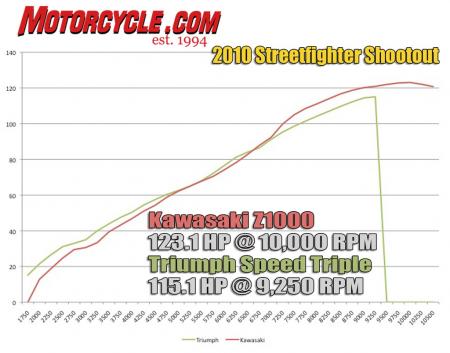
|
Although some hardcore sportbikers might decry any tuning for torque, the Z1000’s mill is a gem in all street situations. The grunty engine is very civilized when ridden sedately, and Kawi has done an excellent job at damping annoying engine vibes from this latest Z.
 “Detuned” isn’t a word thought of when riding a Z1000.
“Detuned” isn’t a word thought of when riding a Z1000.This isn’t to say the 1043cc powerplant is docile. Good clutch take-up feel and strong torque allow for Usain Bolt-like sprints from a stop, a rider able to float the front wheel from a near standstill. Published tests indicate the new Z is able to do 10.5-second quarter-miles and top out at nearly 150 mph.
Throttle response, like its styling, is sharp, except for occasional soggy response when grabbing big handfuls during roll-ons, as if the fuel-injection’s ECU-controlled sub-throttles aren’t sure how to react. Its gearbox was mostly light and smooth but occasionally notchy, sometimes not, and it seemed to improve with miles.
The Speed Triple’s three-pot motor remains eminently likeable, offering a smooth yet responsive feel with minimal vibration. The cable-actuated clutch provides predictable take-up, and the sweet-sounding powerplant is always ready to pull with authority. Gearbox action is a bit notchy but positive when switching cogs.
Swervery
Naked sportbikes like these are designed to offer supersport-like performance without the accompaniment of twisted ergonomics, and this pair delivers on that promise. Both are able to deftly transition from docile street scoot to ravenous corner eater.
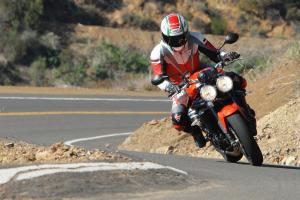
|
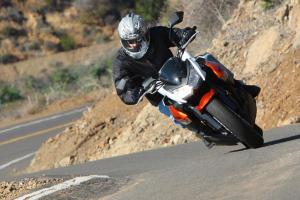
|
The Z1000 easily tips into corners and nearly matches the agility of the flickable Mr. Speed. In the triumvirate of chassis geometry (rake, trail and wheelbase), the Triumph has the sportiest specs in two categories. Its 23.5-degree rake is 1.0 degree steeper than the Kawi, and its minimal 84mm of trail undercuts the Zee by 19mm. Its 56.1-inch wheelbase is longer by 0.4 inches, but its 180mm Metzeler Sportec M3 rear tire is easier to turn than the fatter 190 Dunlop D210 on its rival.
Pointed down a canyon road, the Speed Triple is very cooperative and easy to ride quickly. It’s not until ridden really aggressively that it becomes a bit unraveled, and its minimal amount of trail doesn’t offer the more secure feedback from the Kawi. On the other hand, the Z1000 retains its composure when pushed to its limits. It turns in quickly yet securely, responding without quirks, and it would transition to track work better than the looser Triumph.
“Within the first few curves encountered while aboard the new Z, one of the first impressions that came to mind was that this bike could easily go from the dealer floor straight to the racetrack,” says road-testing fool Pete Brissette. “From front to rear, the entire package feels taut, yet it’s not so rigid that it feels (or responds) like it’s uncomfortably stiff. “
Each bike has a really good set of binders, both utilizing a radial-pump master cylinder and radial-mount calipers on dual front discs. The Kawi’s Tokico calipers have a softer initial bite than the Trumpet’s Brembos but have plenty of power when squeezed deliberately, making them ideal for a streetbike. The Z’s 300mm front rotors are 20mm smaller than the Triple’s but don’t seem to suffer for it.
With their fuel tanks full, this duo weighs within a couple of pounds of each other, about 480 lbs. The S3 wins bonus marks for carrying 0.8-gallon more petrol than the Z1K’s smallish 4.0-gallon fuel tank.
Daily Grind
Both of these machines exemplify the livability of the naked sportbike genre. Their upright riding positions are much preferable to race-replica sportbikes during commuter and errand roles. The Speed Triple’s thickly padded seat, at 32.7 inches, is quite tall, while the Z1000’s stated seat height of 32.1 inches feels even lower than that. Shorties may prefer the Z saddle, but tall folks will appreciate the S3’s greater seat-to-peg distance. The Triumph’s seat has more padding, but the Z’s thinner seat is perfectly comfortable over hour-plus stints. The Speed Triple’s tapered aluminum Magura handlebar is placed a bit further from a rider than the Z’s bar.
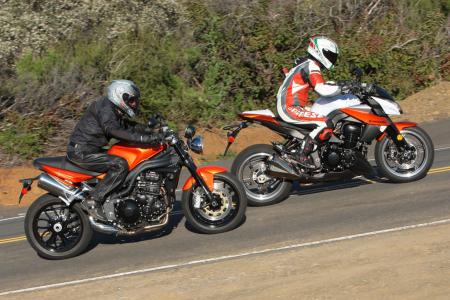
|
This pair’s instrumentation provides similar info in different ways. The Triumph has a digital speedo set into an easily read analog tachometer, augmented by an LCD display on the left that includes a fuel gauge and clock. A gear-position indicator is absent from both bikes.
 We’ve never been fond of bar-graph tachometers, and we like them less when they’re too small to see at a glance.
We’ve never been fond of bar-graph tachometers, and we like them less when they’re too small to see at a glance.The Kawi’s gauges are more controversial. The single-pod unit can be cleverly tilted to three positions, but the yellow-tinted gauge face looks like something out of a J.C. Whitney catalog. Its display includes good stuff like a digital speedo, clock, twin tripmeters and fuel gauge, but we found the bar-graph LCD tachometer difficult to read at a glance. That said, the Zee has such a wide powerband that there’s seldom a reason to check engine speed. At night the LCD display turns red inside the yellow frame.
We like the Z1000’s turnsignals mounted unobtrusively in the vestigial side fairings and the smoothly contoured die-cast aluminum subframe that has integrated grab handles molded into its underside. Less thought was put into its mirrors that are placed too far inboard, necessitating an arm tuck when checking your Six. The Triumph’s mirrors make up in usability what they give up in style.
Despite what appears to be minimal wind protection, an 80-mph cruise on the Z1000 doesn’t batter the rider. Highways speeds are less comfortable on the totally naked Triumph, so we highly recommend the accessory flyscreen that helps divert the wind.
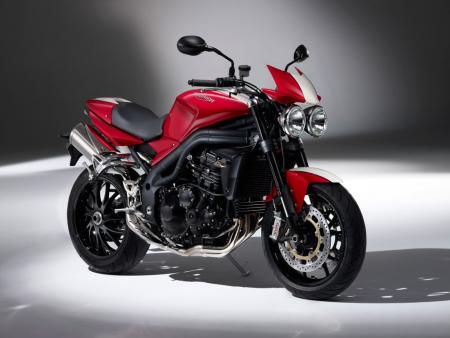
|
The suspensions of both bikes are fully adjustable, so riders of different sizes and abilities will be able to tune them in. The S3’s setup is a bit softer, which is appreciated when the roads are harsh but is less buttoned down when hammered. A new-for-2010 Special Edition Speed Triple ushers in an upgraded suspension for the model, using firmer damping and a slightly softer rear spring.
Style Council
 Despite its aging design, the Speed Triple remains a seductive hooligan machine.
Despite its aging design, the Speed Triple remains a seductive hooligan machine.It’s tough to beat the stripped-down brawler personality of Triumph’s prototypical streetfighter, from its twin-headlight nose to its truncated rear. Bonus points are earned for the stubby high-mount mufflers and single-sided swingarm that expose the lovely rear wheel. An arbitrary point is deducted for the multitude of hoses cluttering up the engine, although they are camouflaged in a sea of black.
The future-forward styling of the Zee hits viewers in different ways. Some traditionalists see it as a caricature, but many expressed appreciation for its ultra-contemporary chunky design.
“Now that is a sick motorcycle!” raves MO forum member Kenneth Moore. “It looks mean as hell and ready to ride over a gaggle of nuns on their way to confession. The fairing gizmos that stick out from the sides are a little much, but it’s still dope. Neat, neat, neat.”
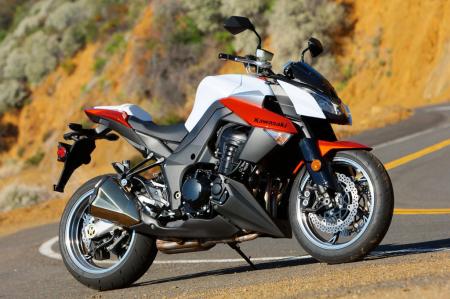
|
And The Winner Is…
 The Triumph Speed Triple: Still a thrill!
The Triumph Speed Triple: Still a thrill!This was a close one. The three-cylinder Triumph has an undeniably desirable character. Its simple yet exotic styling has enduring appeal, and its torquey engine is a pleasure to feel and to hear.
“I used to think the Speed Triple was once a bike I’d always place in my Top 5 faves, but having now ridden the Z, the Speed has some tough competition,” Pete ponders. “Despite the Trumpet losing some performance ground to the new Z, the Kaw can’t hold a candle to the wonderfully raspy Triple exhaust note. And if you’ve ever heard a Triumph Triple fitted with aftermarket Arrow Exhaust systems, well, sir, that right there is the Speed’s siren song, wooing all who hear to come hither.”
The Speed Triple retails for a reasonable $11,299, definitely the best bang for the buck in Euro streetfighter realm. It’s cheaper by thousands than the Aprilia Tuono, Ducati Streetfighter and MV Agusta Brutale.
But so is Team K’s new urban-assault terror, and its ultimate performance limits are higher than the venerable Speed Triple’s. It is a sharper – styling, throttle response, suspension – tool. This is a machine that can holeshot a ZX-10R and run away from a well-ridden supersport on a twisty road.
Adding into the equation the Zee’s modest $10,499 MSRP (the same as a 600 supersport), and it becomes perhaps the best value in all of sportbikedom.
“The S3 is fun, but the Z1000 is more funner,” says Pete.” The re-born Zed is a sportbike slayer.”
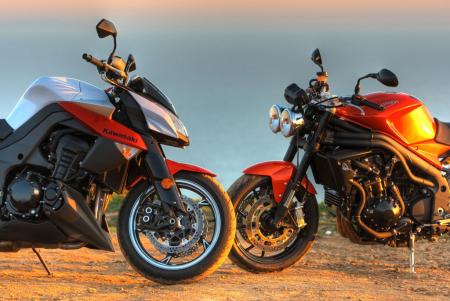
|
Related Reading
2010 Kawasaki Z1000 Review
2009 Streetfighters Shootout
2008 Triumph Urban Sports Review
2008 Triumph Speed Triple Review
The post Church of MO: 2010 Streetfighter Shootout: Kawasaki Z1000 Vs. Triumph Speed Triple appeared first on Motorcycle.com.
Source...

